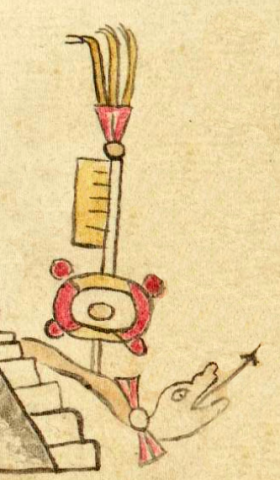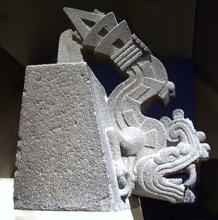Xiuhcoatl (Azca12)
This compound glyph presents the name of a divine force, Xiuhcoatl (typically translated as "Fire Serpent" or "Turquoise Serpent," given that fire and turquoise are related). The serpent or snake is descending down the steps of a pyramid (see the contextualizing image for a better view). The descent is mentioned in the gloss, as well ("Xiuhcoatl descended there") and it is represented in a stone carving of the Fire Serpent located in the British Museum (see below).
The serpent's white head is much larger, proportionally, than its light-brown body. Its eye is open and its tongue protrudes from its open mouth. The tongue has an arrow point, rather than being bifurcated. A red and white bow tie appears at the neck of the serpent. A banner with a long post comes up from the serpent's back. The yellow banner flies to the viewer's left, and above the banner is a red and yellow feather fan, also attached to the pole. Between the banner and the snake is a symbol for ilhuitl (a day), if we compare it to other representations of days in this manuscript. This one has four small red circles on the perimeter of concentric circles that are red, yellow, and white.
Stephanie Wood
It would make the most sense if the middle element were a representation of xihuitl (turquoise), but this does not seem to be the case. The arrow point of the serpent's tongue would appear to represent European stylistic influence.
Stephanie Wood
xiuhcohuatl oncatemoc
Xiuhcoatl onca temoc
Stephanie Wood
post-1550, possibly from the early seventeenth century
Jeff Haskett-Wood
banderas, días, soles, serpientes, abanicos, plumas
This stone carving of Xiuhcoatl in the British Museum (taken from Wikipedia) shows the Fire Serpent descending what may be a pyramid, too. The descent seems to be an integral part of the story in both cases. Click here for more information on the piece in the BM.

xihui(tl), turquoise, https://nahuatl.wired-humanities.org/content/xihuitl-0
coa(tl), snake, serpent, https://nahuatl.wired-humanities.org/content/coatl
Serpiente de Fuego
Stephanie Wood
The Codex Azcatitlan is also known as the Histoire mexicaine, [Manuscrit] Mexicain 59–64. It is housed in the Bibliothèque Nationale de France, and hosted on line by the World Digital Library and the Library of Congress.
https://www.loc.gov/resource/gdcwdl.wdl_15280/?sp=12&st=image
The Library of Congress is “unaware of any copyright or other restrictions in the World Digital Library Collection.” But please cite Bibliothèque Nationale de France and this Visual Lexicon of Aztec Hieroglyphs.







